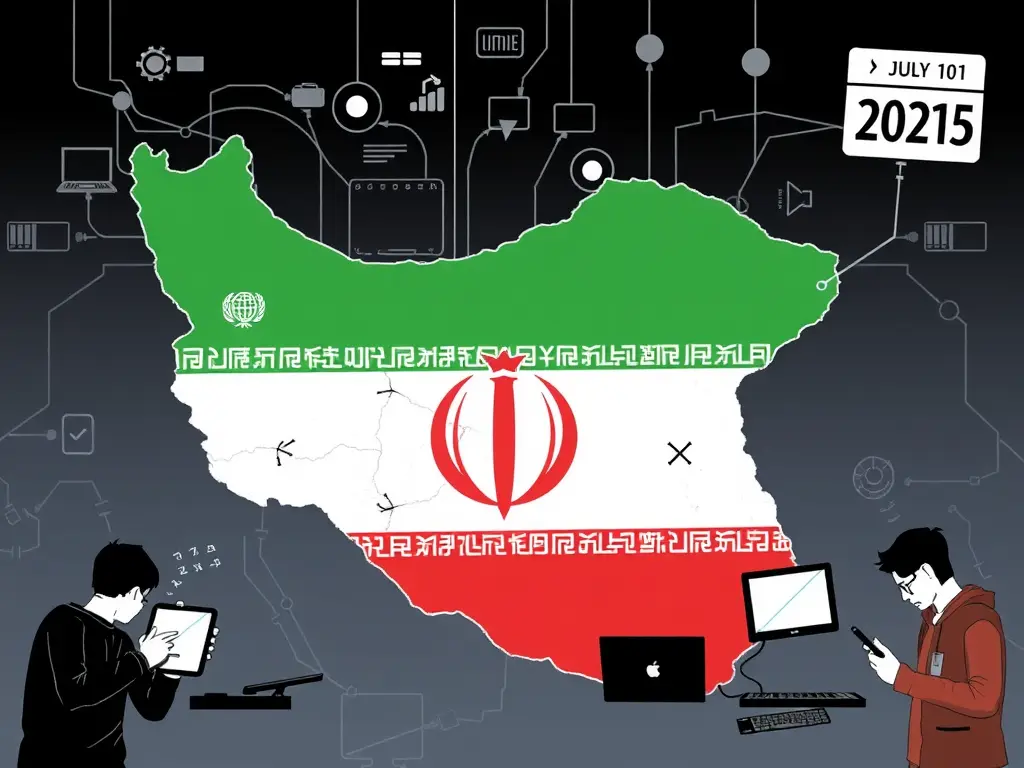Iran’s Internet: Ongoing Instability and the Echo of July 10, 2025
In today’s interconnected world, the internet is an indispensable artery for communication, commerce, and daily life. Its stability and speed directly impact every facet of society. In Iran, the state of internet connectivity has been a consistent and pressing concern for users, businesses, and even government officials. While this article revisits the severe internet disruption reported on July 10, 2025, it’s crucial to acknowledge that internet stability remains a significant challenge for Iranian citizens even today, August 2, 2025. The events of last month, coming just two weeks after an announced “ceasefire” in the communications sector, continue to raise profound questions about the promises of the Ministry of Communications and the future trajectory of Iran’s digital infrastructure.
This article provides an in-depth examination of the severe internet disruption on July 10, 2025, a critical case study in Iran’s ongoing internet struggles. We will explore the potential root causes of this disruption, its far-reaching effects on people’s lives and businesses, and any official reactions. Our goal is to offer a comprehensive and impartial analysis of the internet situation during that period and its lasting implications, helping both ordinary users and IT experts gain a deeper understanding of the persistent challenges in this vital sector.
The Internet Landscape Before July 10, 2025: What Followed the “Ceasefire”?
To fully grasp the events of July 10, 2025, it’s crucial to understand the preceding internet landscape. Users’ reference to “two weeks after the ceasefire” suggests a pivotal moment or a prior agreement aimed at improving or relaxing internet restrictions. This “ceasefire” might have referred to a temporary halt in implementing restrictions, promises to increase bandwidth, or an understanding among various governmental bodies regarding cyberspace management. However, recent reports, including those from June and July 2025, have consistently highlighted frequent internet outages in Iran, often attributed to security concerns, national exams, or general infrastructure issues, indicating a pervasive pattern of instability that predated and continued beyond the “ceasefire.”
Following this “ceasefire,” there was an expectation of relative improvement in internet quality and stability. However, the severe disruption reported on July 10, 2025, starkly revealed that these expectations were unmet; instead of improving, the situation deteriorated into a “crisis.” This glaring contradiction between official promises and the on-the-ground reality fueled widespread dissatisfaction among users and businesses, many of whom rely on the internet for their very survival. Even as of today, August 2, 2025, public sentiment often reflects a deep-seated frustration with inconsistent connectivity.
Analyzing the internet situation during this period necessitates a review of public reports, technical data from internet service providers (if available), and official statements. Such an examination can help determine whether the disruptions were solely due to technical issues or if other factors, such as targeted restrictions or intentional throttling, played a significant role. The lack of transparent, real-time data from official sources often forces analysts to rely on anecdotal evidence and third-party monitoring.
Severe Internet Disruption on July 10, 2025: Nature and Extent
What specific types of disruptions were reported on July 10, 2025? Were these nationwide or confined to particular regions? Which services were most affected? The answers to these questions are essential for understanding the nature of that day’s internet crisis and how it aligns with ongoing issues.
Internet disruptions manifest in various forms: a drastic decrease in speed, complete loss of connection, difficulty accessing specific websites or services (like social media or international messaging apps), and increased latency (response delay). Reports of “severe disruption” typically involve a combination of these issues or one of them on a large scale. On July 10, 2025, multiple sources indicated a widespread slowdown and restricted access to international platforms, affecting a broad user base across different provinces.
Examining public reports on social media and disruption tracking platforms, like those active today, August 2, 2025, can provide an initial snapshot of the geographical scope and type of disruption. Were users across the country complaining about slow or no internet? Was access limited only to international sites and services? These details offer crucial clues about the primary cause. For instance, widespread and simultaneous disruption to foreign services strongly suggests issues at international traffic exchange points or the implementation of new filtering policies. In contrast, more localized disruptions could stem from infrastructure problems at the provincial or regional level.
Beyond public accounts, technical data from network monitoring tools holds immense importance. Ping, traceroute, and download/upload speed graphs can objectively illustrate the severity and type of disruption at various network points. Expert analysis of this data can precisely identify bottlenecks and problematic areas within the country’s internet infrastructure, a process that continues for current disruptions.
Potential Causes of the July 10, 2025 Disruptions: Uncovering the Roots
Pinpointing the main cause of the severe internet disruption on July 10, 2025, requires careful consideration of several potential factors. Technical glitches, infrastructure deficiencies, and policy decisions can all contribute to such outages, often in complex, interconnected ways.
One plausible reason is technical problems within the network infrastructure. These could include equipment failures in data centers, cuts in fiber optic cables along main communication routes, or issues with core network routers and switches. High traffic loads during peak hours can also lead to slowdowns and disruptions, especially if network capacity hasn’t kept pace with demand growth, a common issue in rapidly digitizing economies.
Another factor could relate to updates or unintended changes in network configurations. Sometimes, implementing changes to network equipment settings without proper coordination or testing can trigger widespread and unexpected disruptions. Cyberattacks, such as Distributed Denial of Service (DDoS) attacks, also pose a constant threat to network stability, though officials are typically cautious about providing transparent reports on such incidents. The opacity surrounding these events often fuels speculation.
However, within the context of Iran’s internet, governmental decisions and policies are among the most significant influencing factors. Targeted restrictions on access to specific foreign websites or services, increased filtering, or attempts to direct traffic towards the National Information Network (NIN) can inherently cause disruption or slow down for users. The reference to a “ceasefire” followed by a lack of improvement strongly suggests the influence of non-technical factors (political or managerial) in causing the July 10, 2025, disruptions. The ongoing discussions about the development and implementation of the NIN continue to shape the internet experience in Iran, with a clear focus on national control.
Analyzing official reports (if available) and statements from officials regarding the cause of these disruptions is important, although often these explanations are vague or insufficient, and the reality on the ground does not align with official reports. This lack of transparency remains a critical challenge for users and businesses alike.
Impact of the July 10, 2025 Disruption on People’s Lives and Businesses
The severe internet disruption on July 10, 2025, regardless of its cause, had significant negative impacts on people’s daily lives and the country’s economic activities. The increasing reliance of society on the internet means that any widespread disruption can have serious and cascading consequences. This was evident then and remains true today, August 2, 2025.
For ordinary users, this disruption meant difficulty or impossibility of accessing information, using social media to communicate with friends and family, watching online content, or utilizing online banking and government services. In a world where many daily tasks have moved online, internet disruption causes wasted time, increased stress, and widespread public dissatisfaction. The inability to connect becomes an immediate impediment to modern living.
The impact of this disruption on businesses is far more serious. Online businesses, e-commerce stores, freelancers, knowledge-based companies, and even traditional businesses that use the internet for communication with customers or managing their operations, all suffered losses. The inability to process orders, communicate with customers, or access online work tools and platforms can lead to reduced revenue, loss of job opportunities, and a significant weakening of the overall business environment. This creates an unpredictable and challenging landscape for economic growth.
Furthermore, vital sectors such as online education, remote work, and even some online medical services were also severely affected. Internet disruption can halt the education process for students, eliminate the possibility of remote work, and limit access to crucial telemedicine services. These consequences clearly demonstrate that internet disruption is not merely a technical problem but a profound social and economic issue with broad and detrimental dimensions.
Official and Public Reactions: Silence or Transparency?
In the face of the reported severe internet disruption on July 10, 2025, what were the official and public reactions? Did officials provide transparent information about the cause and estimated duration of the disruption? What was the reaction of users and the community to this situation? These questions remain pertinent for current internet issues in Iran.
Experience shows that during widespread internet disruptions in Iran, official communication usually occurs with delay, and sometimes the explanations provided are not convincing for users. Was the situation similar on July 10, 2025? Did the Ministry of Communications or other responsible bodies issue a timely and clear statement? Was the cause of the disruption (technical, infrastructural, or policy-related) clearly announced? The answers to these questions profoundly impact the increase or decrease of public distrust regarding internet management in the country. Unfortunately, a consistent pattern of delayed or vague official responses continues to erode public confidence.
In contrast, public reaction is usually swift and widespread. Users immediately share their experiences on social media, complain about the existing situation, and sometimes offer their own analyses regarding the cause of the disruption. Hashtags like #internet_disruption quickly trend, becoming a vital space for information exchange and expressing dissatisfaction. These public reactions, although sometimes accompanied by unverified information due to the lack of official transparency, strongly indicate the internet’s critical importance for society and the public’s sensitivity to its stability.
Comparing official reports (if any) with users’ real-world experiences consistently reveals a significant gap between the official narrative and the actual reality. Transparency in reporting and accountability for the problems that arise are crucial steps towards rebuilding public trust and ensuring proper crisis management—steps that are still widely called for today, August 2, 2025.
Lessons from the July 10, 2025 Disruption: Looking Ahead
The report of severe internet disruption on July 10, 2025, regardless of its precise causes, carries important and ongoing lessons for stakeholders and users. This incident, and similar ones observed since, have repeatedly exposed the vulnerability of the country’s communication infrastructure and the serious consequences of internet instability.
For officials, this report serves as a persistent alarm bell, indicating that promises of improving the internet situation must be accompanied by practical and tangible actions. Sufficient, sustained investment in developing and updating technical infrastructure, increasing international bandwidth capacity, and transparent policies regarding restrictions can help ensure greater network stability. Furthermore, developing and implementing robust crisis management plans for widespread disruption events is essential to ensure timely and accurate information dissemination and to take necessary measures to mitigate consequences. This proactive approach is currently lacking and desperately needed.
For users and businesses, these recurring disruptions highlight the necessity of being prepared to face such conditions. Having backup plans for accessing essential information and tools during internet outages, utilizing offline services where possible, and geographically diversifying operations to reduce risk can be beneficial strategies. Additionally, increasing public awareness regarding users’ rights in the realm of the internet and pursuing demands through legal and civil channels remains important for advocating for better connectivity.
The future of the internet in Iran largely depends on the approach of the government and responsible institutions towards this vital sector. Will the priority be the continuous development of infrastructure and ensuring free and stable access for users, or will concerns about controlling and restricting cyberspace continue to outweigh other considerations? The experience of July 10, 2025, and subsequent events, consistently demonstrate that the current situation is far from expectations, and there is a significant distance to cover to achieve a truly stable and reliable internet for all Iranian citizens.
Conclusion
The report of severe internet disruption on July 10, 2025, serving as a bitter and illustrative turning point, was a stark reminder of the fragility of internet infrastructure in Iran and its profound impacts on daily life and the country’s economy. This disruption, which occurred contrary to promises of improvement after a “ceasefire” period, raised serious questions regarding the effectiveness of policies and management in the communications sector—questions that persist even today, August 2, 2025.
To build a future where the internet is not a challenge but a powerful tool for growth and development, there is an urgent need for sustained investment in infrastructure, increased transparency in decision-making and policymaking, and serious attention to the rights and needs of users and businesses. Overcoming internet crises in Iran requires a comprehensive approach that includes both robust technical dimensions and forward-thinking policy and social dimensions.
It is hoped that by continuously learning from experiences like the July 10, 2025, disruption, more effective and citizen-centric steps will be taken towards ensuring stable, fast, and free internet access for all Iranian citizens. Internet stability is, unequivocally, the stability of life in the digital age.






